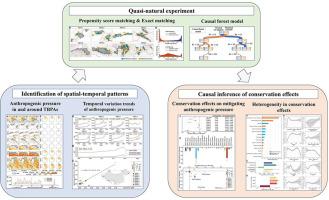跨境保护区对缓解中国边境人为压力的保护作用
IF 11.2
1区 环境科学与生态学
Q1 ENGINEERING, ENVIRONMENTAL
引用次数: 0
摘要
陆地边境地区不断升级的人为压力是跨境生态系统面临的主要威胁之一。为了实现有效的跨境保护,周边国家需要明确人为压力的空间格局和变化趋势,以及跨境保护区(TBPA)对抵御人为压力的影响。本研究基于夜间光照、人口密度、不透水地表数据和因果推断方法,调查了具有不同社会经济和自然背景的中国跨境 TBPA。我们发现,特变电工保护区和周边非保护区都经历了人为压力的显著增加,特变电工保护区的极高压力比例从 2000 年的 0.43% 增加到 2020 年的 1.19%。TBPA有效缓解了23.91%的人为压力增长趋势,但不同TBPA和不同国家的保护效果存在差异。这些结果凸显了加强国际合作以应对人为压力和促进跨境地区可持续生计的必要性。本文章由计算机程序翻译,如有差异,请以英文原文为准。

Conservation effects of transboundary protected areas on mitigating anthropogenic pressure across China's borders
The escalating anthropogenic pressure in terrestrial borderlands is one of the major threats to transboundary ecosystems. To realize effective transboundary conservation efforts, neighboring countries need to clarify the spatial patterns and variation trends of anthropogenic pressure, as well as effects of the transboundary protected area (TBPA) on resisting anthropogenic pressure. This study investigated TBPAs across China's borders with diversified socioeconomic and natural backgrounds based on nighttime light, population density, impervious surface data and causal inference methods. We found both TBPAs and surrounding unprotected areas experienced significant increase of anthropogenic pressure, and the proportion of very high pressure in TBPAs expanded from 0.43 % in 2000 to 1.19 % in 2020. TBPAs effectively mitigated the growth trend of anthropogenic pressure by 23.91 %, however there's discrepancy in conservation effects among different TBPAs and countries. These results highlight the necessity to enhance international collaboration to address anthropogenic pressure and promote sustainable livelihoods in transboundary areas.
求助全文
通过发布文献求助,成功后即可免费获取论文全文。
去求助
来源期刊

Resources Conservation and Recycling
环境科学-工程:环境
CiteScore
22.90
自引率
6.10%
发文量
625
审稿时长
23 days
期刊介绍:
The journal Resources, Conservation & Recycling welcomes contributions from research, which consider sustainable management and conservation of resources. The journal prioritizes understanding the transformation processes crucial for transitioning toward more sustainable production and consumption systems. It highlights technological, economic, institutional, and policy aspects related to specific resource management practices such as conservation, recycling, and resource substitution, as well as broader strategies like improving resource productivity and restructuring production and consumption patterns.
Contributions may address regional, national, or international scales and can range from individual resources or technologies to entire sectors or systems. Authors are encouraged to explore scientific and methodological issues alongside practical, environmental, and economic implications. However, manuscripts focusing solely on laboratory experiments without discussing their broader implications will not be considered for publication in the journal.
 求助内容:
求助内容: 应助结果提醒方式:
应助结果提醒方式:


